Art & Exhibitions
Janet Cardiff and George Bures Miller Hit All the Right Notes at Luhring Augustine
The more people approach the work, the more intense it becomes.
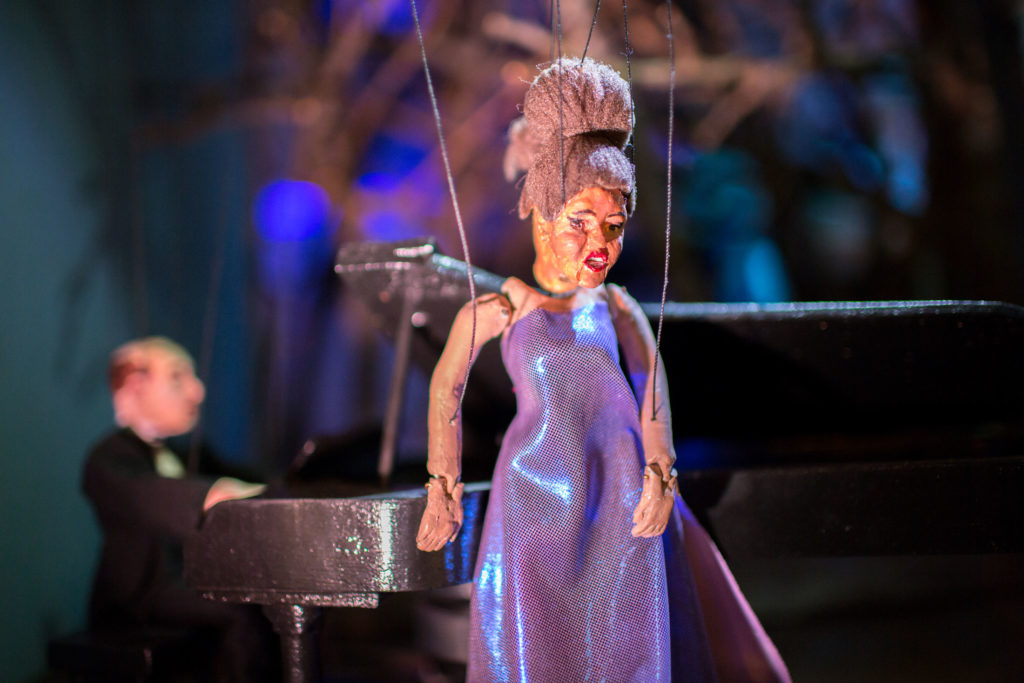
The more people approach the work, the more intense it becomes.

Madeline Coleman

It has become relatively easy to find a New York gallery with a good puppet show these past few years. There was Paweł Althamer’s 2014 exhibition at the New Museum, featuring both small and life-size figures and stop-motion animation; Wael Shawky’s video retelling of the Crusades using marionettes, at MoMA PS1 a year later; and even Alexander Calder’s Circus, one of the favorites from the Whitney’s opening exhibition downtown. Not to mention the zoetrope in Camille Henrot’s Metro Pictures show last fall, a whirling dervish of inch-worming cigarettes and cascading prescription pills.
These low-tech sleights of hand are a welcome antidote to the slick digital interfaces that dominate so many of our days. Curators and institutions may also be keen to spotlight work that will feel accessible to those who might otherwise avoid contemporary art—fearing pretension or illegibility, or both. Nonetheless, artists like Althamer use these mediums to tackle death and identity, as an innocuous shell for a darker message. This is the marionette not as plaything, but as golem.
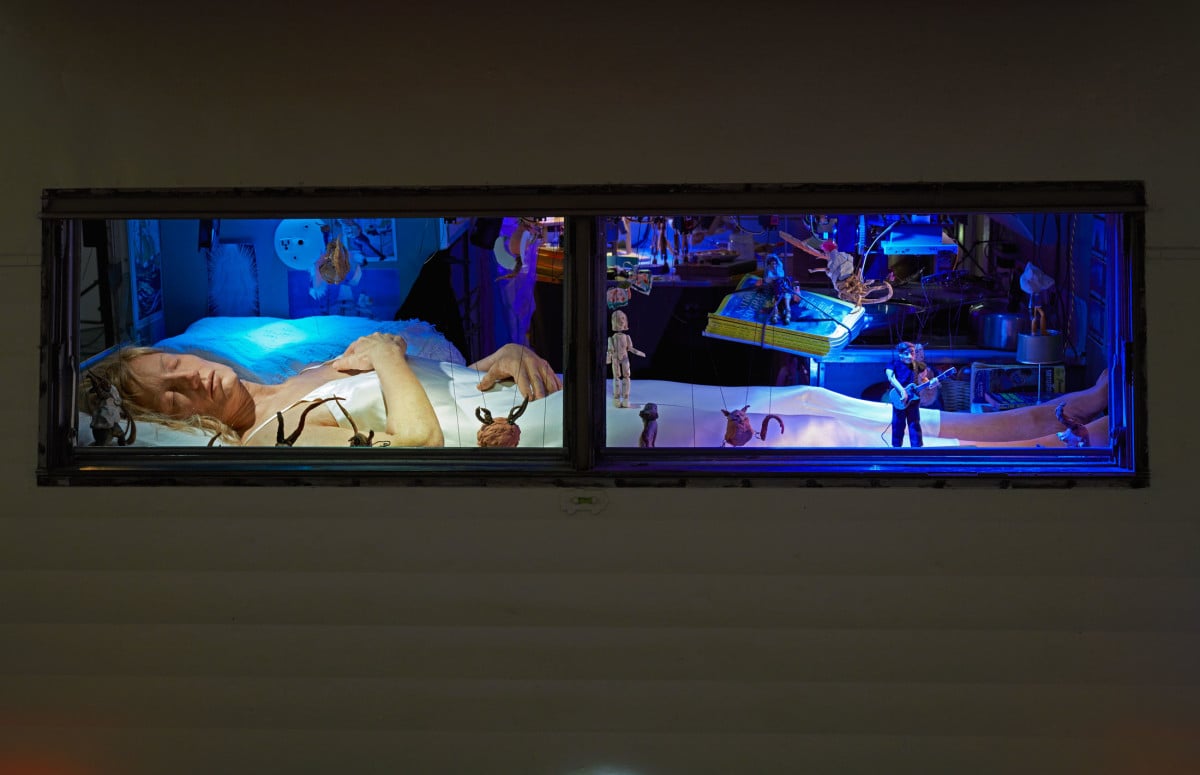
Janet Cardiff and George Bures Miller, The Marionette Maker (2014).
Image: © Janet Cardiff and George Bures Miller; Courtesy of the artists, Luhring Augustine, New York, and Museo Nacional Centro de Arte Reina Sofia, Madrid.
Janet Cardiff and Georges Bures Miller’s latest exhibition at Luhring Augustine’s West 24th Street space, The Marionette Maker, follows this line of thought by transforming an automated puppet show into a nocturnal dreamscape, one that questions who’s really pulling the strings. The eponymous work takes place in an 11-foot-long camping trailer topped with enormous megaphones, parked in the darkened gallery.
At one end, a robot-controlled marionette fidgets at a small desk atop a human-sized table, worrying over his sketches, while a waxy, human-sized mask of a face, eyeballs twitching in their sockets, occupies the larger table. Pulpy paperbacks, coffee cups, and other loose ends are scattered about, and cooking implements shift restlessly on the stove. To the rear is a wax-like figure of a sleeping woman in a white slip resting on a bed—the full-sized body double of the sleepwalking puppet. All around and above her bounce marionettes that range from a tiny, lifelike guitarist to anthropomorphic globs of clay with wings and eyes pasted on them, jittering in place.
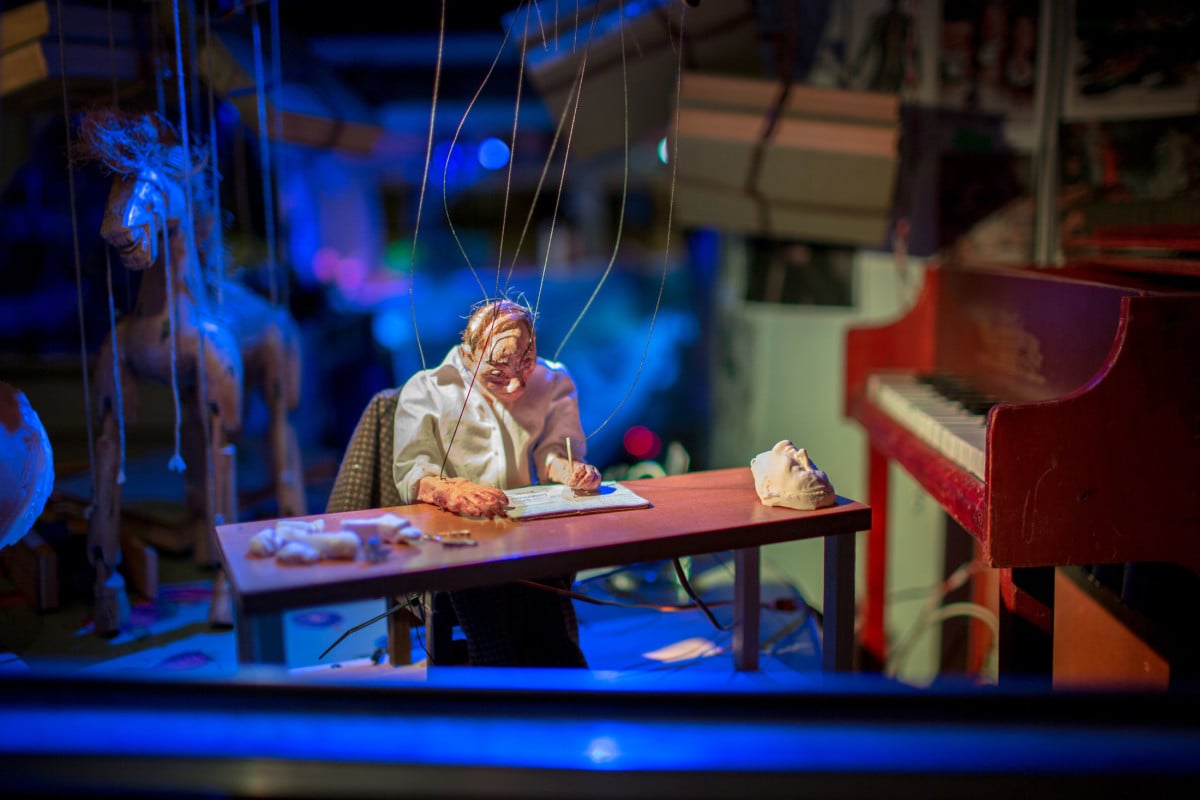
Janet Cardiff and George Bures Miller, The Marionette Maker (2014).
Image: © Janet Cardiff and George Bures Miller; Courtesy of the artists, Luhring Augustine, New York, and Museo Nacional Centro de Arte Reina Sofia, Madrid.
Cardiff and Bures Miller are known for their monumental sound installations, such as The Murder of Crows, which was installed in the huge hall of the Park Avenue Armory a few years ago. Their sound work weaves choral and instrumental music with speech, nature sounds, and Foley-esque effects. But they know how to play with visual environments too, and The Marionette Maker is a coral reef of detail: a tiny opera singer and her pianist burst into song from one of the trailer’s sides, complete with human-sized theater seats from which to watch them; a model ship tosses on a tulle sea; a starry sky glimmers darkly through a high-up window. A looping soundtrack of driving guitar fades into animal calls, thunderclaps, and the sound of rain on a cold tin roof. The trailer is a self-contained world in what seems to be a desolate rural landscape, teeming in isolation.
Another piece by the artists, Experiment in F# Minor, is installed in the rear gallery. It has a simpler set-up: in a dramatically lit, insulated room, two wooden tables are covered in speakers and a phonograph horn. Each speaker contains a light sensor, and passing a shadow over it triggers the release of its individual sound, all keyed in melancholy F# minor. As visitors circle the table and trip the speakers, they will hear a combination of dreamy piano tinkling, sighing vocals, breaking glass, and guitar strumming. The more people approach the work, the more intense this “music” becomes: it crackles and wooshes and bangs, building into a tide of noise that rushes out again when the gallery empties.
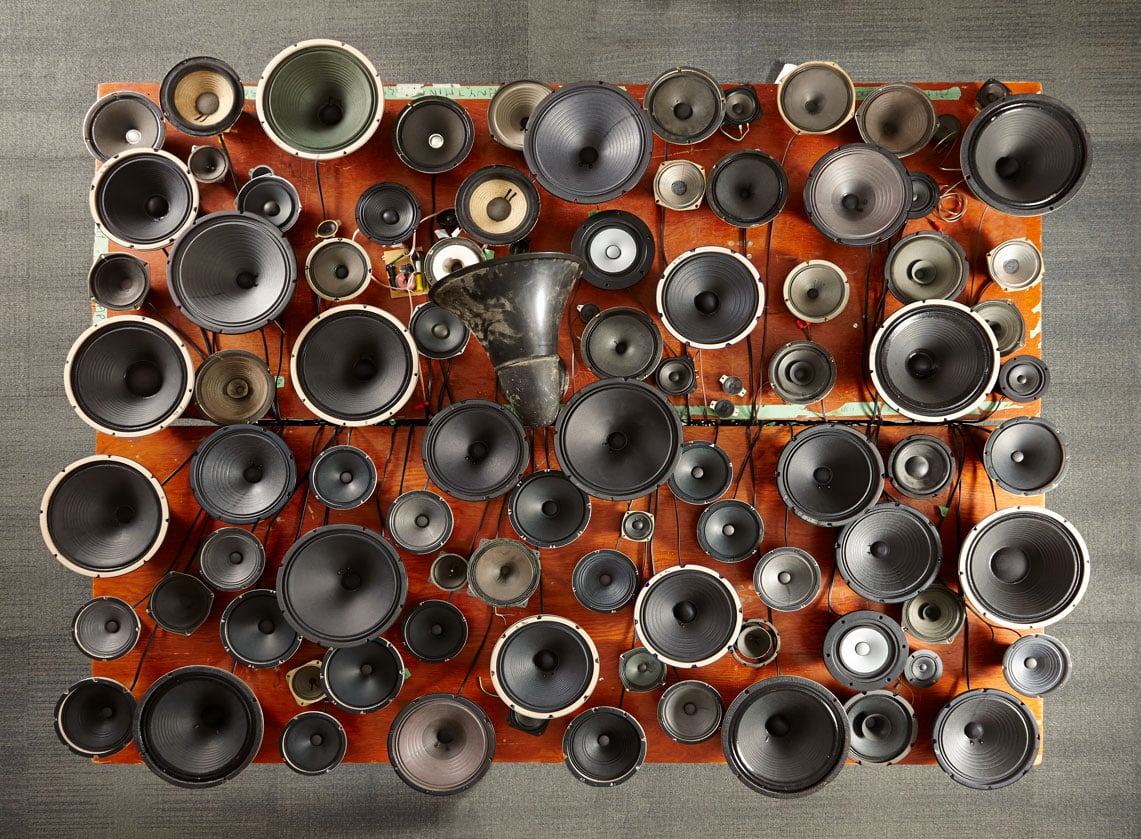
Janet Cardiff and George Bures Miller, Experiment in F# Minor (2013).
Image: © Janet Cardiff and George Bures Miller; Courtesy of the artist and Luhring Augustine, New York.
Both in this work and in The Marionette Maker, Cardiff and Bures Miller seem to twist out of their authorial roles, deflecting attention while they slip out of sight. Just as Experiment in F# Minor depends on the presence of an audience and dismisses the idea of top-down musical composition, you have to wonder who in the trailer is really the “maker” of the title—the tiny man toiling at the desk, or the sleeping woman, who may have made him in the first place? (She bears a resemblance to Cardiff herself, but that may be beside the point.) It’s impossible not to project fairytale narratives onto the strange intermingling of Canadian camping paraphernalia—Cardiff and Bures Miller, a couple, live in rural British Columbia—with marionettes. But it also alludes to the relationship between creativity and control.
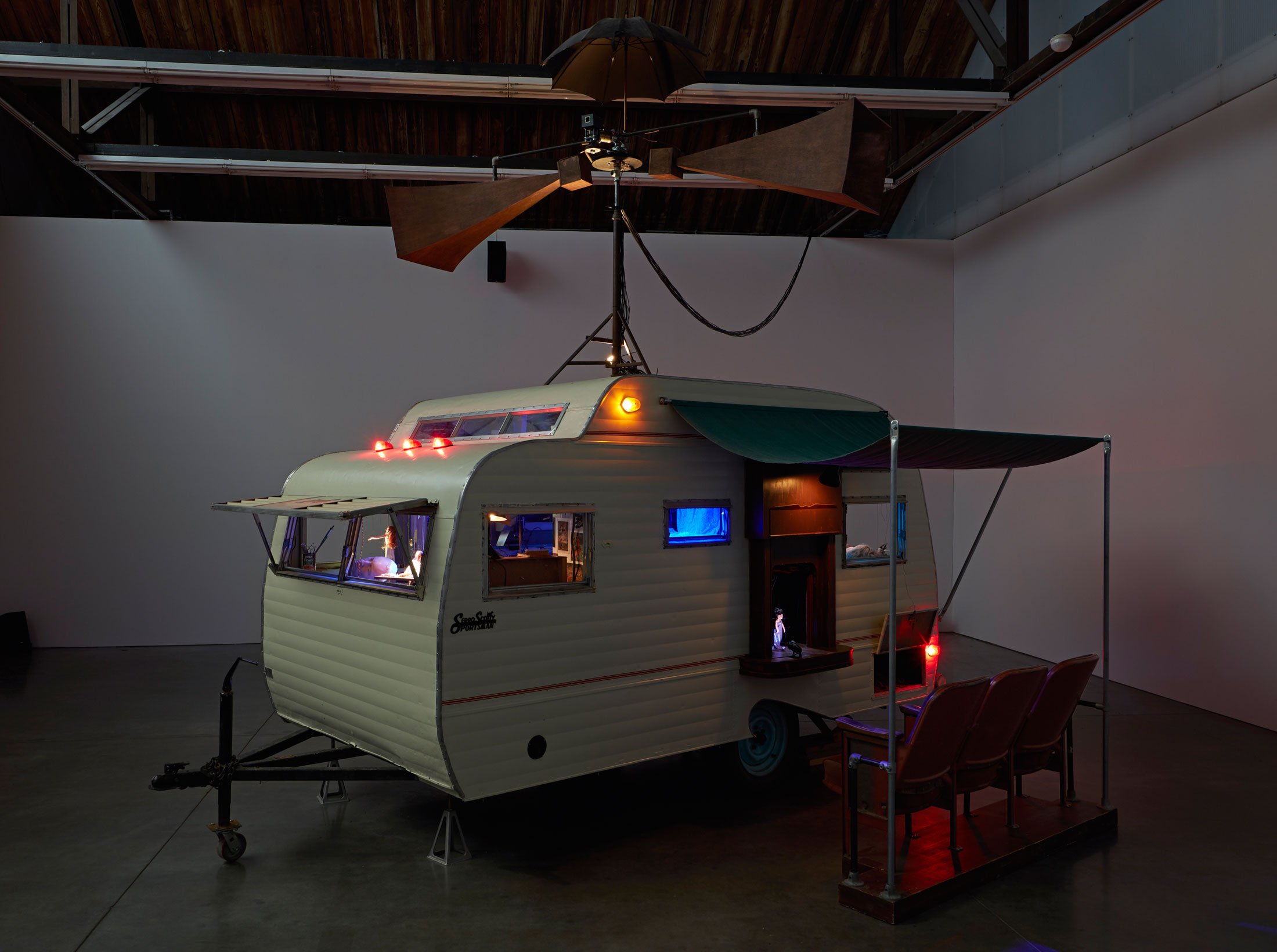
Janet Cardiff and George Bures Miller, The Marionette Maker (2014).
Image: © Janet Cardiff and George Bures Miller; Courtesy of the artists, Luhring Augustine, New York, and Museo Nacional Centro de Arte Reina Sofia, Madrid.
Cardiff and Bures Miller are hard to pin down: their work can recall old radio plays, theater sets, haunted houses, or noise music. Technically gifted, they have been criticized for laying it on too thick, overwhelming audiences with aural stimulation and old-timey props when a more efficient set-up might actually be more effective. For instance, the trailer is so full of moving objects that you never quite feel you’ve spotted it all, and spending time with F# Minor can begin to feel like being trapped under a wave of sound.
But it’s no small trick to make work that’s so immersive yet so ambiguous, toeing the line between beauty and dissonance, wonder and fear. Emerging from the gallery is like being jolted from a dream, the last vibrations of a minor chord still humming in your mind as you step into the light.
The Marionette Maker is on view at Luhring Augustine in New York from April 16 to June 11, 2016.